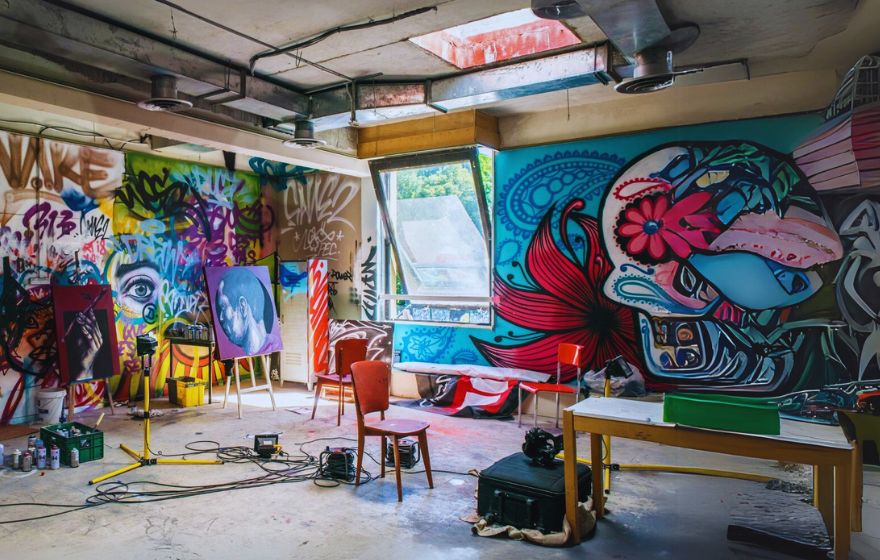Oil painting is a captivating art shape that has stimulated creativity for centuries. Whether you are an aspiring artist or a hobbyist, starting oil painting at home can be an exciting and pleasing experience. This manual will take you step-by-step through the entirety you need to know, from putting in your space to studying important techniques.
Creating Your Painting Space

Why Your Space Matters
Your workspace performs an important position to your painting. A properly-deliberate setup ensures comfort, idea, and practicality.
Choosing the Perfect Spot
- Opt for a room with natural light or sunlight hours lamps for accurate coloration.
- Ensure right air flow, specifically if the use of traditional oil paints with solvents.
- Choose a spacious vicinity wherein you can install an easel and move around without problems.
Organizing Your Supplies
- Use garage bins for paints, brushes, and other gear.
- Protect surfaces with drop cloths or plastic sheets.
- Keep cleansing materials, like rags and solvents, within smooth attainment.
Gathering the Essentials
Basic Tools and Materials
To begin oil painting, you’ll want a few essential components. Start with those basics:
Oil Paints

Choose a beginner-pleasant set with number one colorations, white, and some earth tones. These provide versatility whilst retaining your preliminary investment low.
Brushes

Start with a choice of brushes, consisting of:
- Flat brushes for broad strokes.
- Round brushes for first-rate information.
- Filbert brushes for blending and tender edges.
Canvas and Painting Surfaces
- Stretched canvases are pre-primed and prepared for painting.
- Canvas panels are low-priced and easy to store.
- Wood panels offer a smooth surface for specified work.
Other Supplies
- Palette: For blending paints; pick out glass, wood, or disposable alternatives.
- Palette Knife: For blending or applying paint directly to the canvas.
- Solvents and Mediums: Use linseed oil to adjust paint consistency and mineral spirits for cleansing brushes.
- Easel: Keep your canvas upright for better posture and manipulation.
Getting Started with Oil Painting

Preparing Your Canvas Artwork
If your canvas isn’t pre-primed, follow a layer of gesso to put together the floor. This ensures the paint adheres nicely and prevents oil from soaking into the canvas.
Sketching Your Design
Lightly sketch your problem using a pencil, charcoal, or a skinny paint layer. This facilitates keeping proportions and guides your painting procedure.
Exploring Essential Techniques
Wet-on-Wet (Alla Prima)
This technique includes painting directly onto wet paint, permitting colorations to blend effortlessly. It’s perfect for developing expressive and dynamic portions.
Layering (Fat Over Lean)
Build your painting in layers, starting with thinner (leaner) paint and regularly the usage of thicker (fatter) paint. This prevents cracking and guarantees a long-lasting finish.
Blending for Smooth Transitions
Use a clean, soft brush to combine shades directly on the canvas. This method creates realistic gradients, especially in skies, water, or photographs.
Adding Texture with Impasto
Apply thick layers of paint with a palette knife to create raised, textured regions. Impasto is best for highlighting dramatic brushstrokes.
Staying Inspired While Painting

Finding Your Style
Experiment with specific painting styles to discover what fits you fine. Explore:
- Realism for life is like information.
- Impressionism for smooth, mild-stuffed strokes.
- Abstract to focus on emotions, shapes, and colors.
Seeking Inspiration
Draw thoughts from nature, images, or well-known works of art. Visit galleries or be a part of on-line communities to connect to other artists and stay stimulated.
Caring for Your Tools and Artwork
Cleaning Brushes
After every consultation, clean your brushes very well:
- Wipe off extra paint with a rag.
- Rinse in mineral spirits or a cleansing solution.
- Wash with cleaning soap and warm water until the bristles are easy.
Storing Your Tools
- Keep paints in a cool, dry place.
- Store brushes upright to maintain their form.
- Cover your palette to keep combined colorings for future use.
Drying and Protecting Your Artwork
Allow your painting to dry absolutely earlier than managing. This can take weeks to months, relying on the thickness of your layers. Once dry, follow a varnish to defend your work from dust, UV rays, and damage.
Taking Your Skills Further
As you grow more cushty with oil painting, it’s important to task yourself and discover new strategies. Advancing your talents will not only enhance your technical abilities but also deepen your connection to the art. By experimenting with mediums and tackling greater complicated projects, you’ll find particular methods to express your creativity.
Experimenting with Mediums
Oil paints are versatile, and their properties can be more advantageous with the use of mediums. These components permit artists to adjust drying times, textures, and finishes, imparting extra manipulation over the very last appearance in their paintings. Incorporating mediums into your exercise can raise your paintings to new degrees of class and style.
- Linseed Oil: This traditional medium is a staple for oil painters. Adding linseed oil to your paint will increase its flow, making it simpler to create easy, mixed strokes. It additionally complements the glossiness of the paint, giving your completed piece a polished, professional appearance.
- Liquin: For folks who need to paint faster, liquin is a first rate choice. This medium appreciably reduces drying time, permitting you to build layers greater quickly. Its silky consistency makes it ideal for glazing strategies, wherein transparent layers of color are implemented to create depth and richness.
- Cold Wax: Adding bloodless wax for your paint creates a thicker, greater textured consistency. This medium is best for artists who love working with impasto strategies or want to add a matte end to their artwork.
Experimenting with these mediums offers you the freedom to push the boundaries of your creativity. Each one opens new possibilities, permitting you to explore patterns and strategies that might have appeared daunting before.
Read also: All About Terracotta: The Timeless Art of Clay
Challenging Yourself
Once you’ve mastered the basics, it’s time to stretch your competencies by taking on more ambitious projects. Challenging yourself no longer most effectively enhances your technical abilities however also builds confidence in tackling different subjects and patterns. Stepping out of your comfort area is a crucial part of artistic increase.
Paint Complex Subjects
Portraits and elaborate landscapes are outstanding ways to test your abilities. Portraits require attention to element, expertise of proportions, and mastery of mixing techniques to acquire practical outcomes. Landscapes, however, provide opportunities to play with texture, depth, and lights.
These subjects may additionally seem intimidating in the beginning, however each attempt will sharpen your abilities and improve your artistic eye.
Experiment with Larger Canvases
Transitioning to larger canvases is some other thrilling venture. Bigger surfaces call for greater making plans and manipulate, permitting you to experiment with broader strokes, complicated details, and composition. Painting on a massive scale additionally encourages freedom and boldness on your creative expression, resulting in portions that feel grand and impactful.
Every task you adopt brings you towards coming across your particular fashion and voice as an artist. Embrace those possibilities for increase and take into account that errors are precious learning stories.
Final Thoughts on Oil Painting at Home
Oil painting at home is more than simply a creative interest; it’s a journey of self-expression and exploration. Each brushstroke displays your personal vision, and with time, your talents will flourish. By dedicating yourself to exercise and experimentation, you could transform simple thoughts into stunning masterpieces.
Creating a supportive and provoking surroundings is key to nurturing your creativity. With the right tools, a prepared workspace, and an open mind, the opportunities are countless. Whether you’re blending colorful hues, experimenting with textures, or including intricate info, every second spent painting contributes to your boom as an artist.
Remember, there may be no “right” way to paint. Oil painting is a deeply non-public art form, and your unique angle is what makes your work special. Embrace the procedure, take some time, and have fun your development alongside the manner. With endurance and persistence, your own home studio can emerge as a sanctuary for creativity and an area wherein your inventive adventure simply starts off evolved.
Read more: The Art of Flower Painting: A Timeless Expression of Beauty










2 thoughts on “How to Start Oil Painting at Home: A Complete Beginner’s Guide”